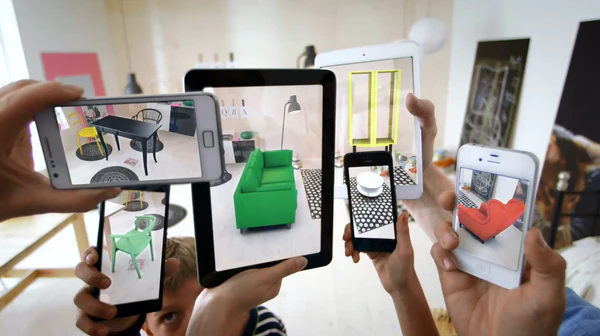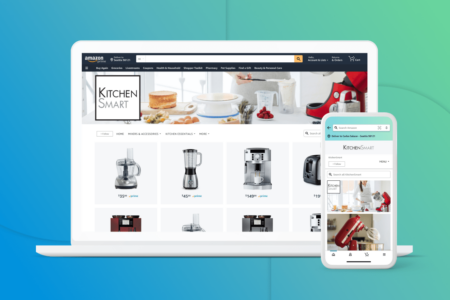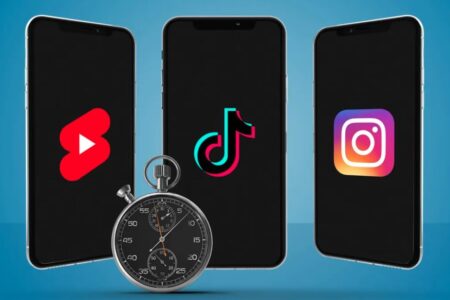Many of us still see the alternate realities built by intelligent computer generations as thrilling pieces of science fiction, reserved for the likes of Star Trek or theories scrawled upon whiteboards in universities.
In truth, that technology is already here, and people and businesses are adopting it across the world.
Augmented and virtual reality has moved beyond the experimental phase and has exploded on the scene with new features in gaming, real estate, corporate training, retail and others, with the potential for many more applications in the future.
One of these possibilities is with a business’s marketing strategy.
In this article, the Clearwater team explore this ever-evolving technology in more detail, how brands are already introducing AR & VR into their marketing campaigns, and some points of consideration on how you can, too.
What is AR & VR Technology?
AR & VR are such innovative pieces of technology poised to change the world, but they are still new concepts for many people, and need some explaining to best recognise their potential:
Augmented Reality
The desire of augmented reality is to create an advanced perception of the reality we all share around us. AR technology takes the approach of a direct or indirect view of a physical environment in the real world with various elements ‘augmented’ through various forms of computer-generated sensory inputs, including animations and graphics, sound effects, and video displays.
AR is a combination of two basic components: a user interface and a display system. The user interface tracks the user’s movements and provides input to the display system, which then augments the real-world environment with the computer-generated information mentioned above.
AR is typically experienced through a mobile device or a headset that allows you to see the real world around you while also seeing computer-generated content.
Virtual Reality
In comparison, virtual Reality technology is an entirely computer-simulated environment allowing users to experience an immersive, three-dimensional world. This cutting-edge technology is often used in video gaming and other entertainment applications, but it has also been used for educational and training purposes.
Users can interact with virtual reality environments using various input devices, including head-mounted displays, hand controllers, and body tracking systems. The level of immersion in these environments can vary depending on the VR system used, with some providing a more realistic experience by stimulating multiple senses, while others focus solely on visual or auditory stimulation.
What is the Difference Between AR & VR Technology?
Despite the descriptions provided above, the acronyms of AR and VR are often used interchangeably. So, what’s the difference between AR and VR?
AR superimposes computer-generated images in the real world, whereas VR creates a completely simulated environment. AR is typically used for entertainment or educational purposes, and VR is used for more immersive experiences such as gaming or training simulations.
1. Display
The most apparent difference between AR and VR is the display. AR devices use see-through lenses to overlay digital content on top of the natural world, meaning users can still see their surroundings with digital content added on top.
In contrast, VR headsets fully immerse users in a digital world. These headsets have opaque lenses blocking out the real world and replacing it with a computer-generated environment.
2. Interaction
Another key difference between AR and VR is how users interact with digital content.
AR devices allow users to interact with digital content using their hands and voice. This natural input form makes it easy to use AR applications for tasks like product design or training simulations.
VR headsets, on the other hand, typically use controllers to track user input. While this can still be an intuitive way to interact with virtual content, it’s not as natural as using your hands, making VR less suited for certain applications.
3. Applications
AR has been used for a wide range of applications, including product design, training simulations, and even video games.
VR, on the other hand, is mainly used for entertainment applications like video games and movies. However, VR is also starting to be used for more practical applications like medical training and even therapy.
How is AR & VR Being Used in Marketing Today?
AR & VR technology is becoming far more widespread in a growing number of industries, with marketing at the forefront. Examples include:
- Vehicle Showrooms: With these technologies, customers can obtain a realistic view of driving a particular car in different locations across the world, offering a new way to increase interest in a new line. Volvo was an earlier adopter of this method, allowing potential customers to take a virtual test drive of their XC90 through a mountain range using only their phones.
- Retail Experiences: VR and AR are also impacting retail experiences, often used to create immersive environments to offer customers a taste of what it would be like to use a particular product before they make a purchase. For example, Ikea has been experimenting with augmented reality to help customers view how certain furniture options work in their homes in real-time.
- Real Estate: The real estate industry greatly benefited from VR and AR throughout the COVID-19 lockdowns when physical visits were no longer possible, and have continued to be applied even with lockdowns being removed. Potential buyers receive a realistic view of what a property looks like inside and out, offering a great way to increase interest in a particular listing.
- Event Experiences: VR and AR can also be used to create immersive experiences for events such as concerts or sporting events. An example would be the NFL experimenting with VR allowing fans to experience what it’s like to be on the field during a game.
- Branded Advertising: Virtual & augmented reality can also be used to create more immersive and interactive advertising experiences. Even McDonald’s has invested in this technology, working to intrigue younger customers with a Happy Meal box that can be transformed into a VR viewer. These ‘Happy Goggles’ display a range of enjoyable and educational games to keep them entertained far more than the little toys ever did!
As you can see, there are many ways that VR and AR can be used in marketing today. These technologies have the potential to change the way businesses reach their target audiences – including your own!
How Can You Introduce AR & VR into Your Digital Marketing Strategy
1. Customers Allowed to Try Before They Buy
Who wouldn’t want to get an idea of a new product or service before forking out the money? It’s the only way to guarantee you’re receiving good value for your investment, right?
Well, not anymore.
AR & VR technology has presented creative solutions where consumers can receive a glimpse into what life would be like after purchasing. This is especially helpful with higher ticket items that require serious consideration before investing, such as high-fashion clothing, furniture, and even vehicles.
By using a smartphone’s camera, for example, customers can scan their living room and see an augmented reality where a new rug or couch is included amongst the rest of the interior décor, giving you an understanding of it works aesthetically. Clothing brands have also been creating virtual changing rooms, either again utilising AR for people to see how shirts, dresses, trousers and even sunglasses look without having to visit a physical store, or by creating a completely virtual reality where users can experiment with mannequins and digital avatars in different settings and combinations.
Further benefits include:
- Allowing potential customers to experience a product firsthand can increase the likelihood of making a purchase.
- It will help build brand loyalty as customers appreciate being able to try out a product before committing.
- The current novelty of AR & VR used in everyday life will help to generate interest alongside the products themselves.
- Businesses can save on housing large inventory on-site solely for potential customers to view and experiment with before buying.
- Stores can shift online, creating further savings on physical premises to achieve the same benefits with users from the comfort of their own homes.
2. Tour a Physical Location Without Visiting
It was only during the pandemic that we, as an advanced society, realised the burden of physically travelling to an office, shopping centre, dealership or any other location to perform day-to-day tasks. We had video conferencing technology beforehand, for example, but only after it was forced to become a mainstream tool did we realise the benefits of working from home or flexible workspaces.
The same thing is happening within the commercial realm with the introduction of AR & VR.
When a business, property or destination is in a hard-to-reach area, only has a limited physical space, or will take a long time (and great expense) to visit, AR & VR can offer a timely and convenient solution. As mentioned above, real estate firms have already been providing virtual tours of vacant residential and commercial properties to viewers across the world.
3. Create & Distribute Engaging Branding Materials
Augmented reality holds the potential to elevate our traditional branding materials and collaterals to exciting new levels.
For example, everyday items like business cards, brochures, flyers and other tangible pieces can have a scannable code that generates exciting and engaging virtual components. This could be further information on a service or product, some interactive solutions on how to make contact with just a click of a button, and even dynamic displays to entertain and make an impression on audiences.
By creating engaging and interactive branding materials, you can reach more potential customers and promote your products or services in a new and innovative way. Additionally, this can help build brand awareness and loyalty as customers appreciate being able to interact with your business in a unique way.
4. Take Advantage of Existing Social Media AR Tools
Social media – still a relatively new piece of technology and communication – holds a significant influence on our modern world. Users of all ages and demographics are spending hours each and every day scrolling through feeds, interacting with friends and family, exploring new features and engaging with different content creators.
Given the rise of different platforms moving in and out of popularity, there is a constant push for new capabilities to be added to improve user experiences. It has been no secret that Facebook and Instagram’s parent company, Meta, is investing heavily in AR & VR technology, steadily releasing new features alongside their wider projects.
And yet, more popular results are being found on apps like Snapchat and TikTok, with their simple yet effective filters and lenses that can be customised and applied to include and promote all sorts of branded experiences.
Features available on each platform include:
Facebook & Instagram
Meta has introduced AR advertising capabilities across Facebook and Instagram with the ability to detect a 3D space that includes objects, walls and even other people, and use it to create a realistic backdrop for realistic and immersive virtual product placement.
The AR Experience template is available in Ads Manager with a range of Spark tools, including product try-ons, face effects, mini-games and more.
Snapchat
Snap AR is constantly evolving to offer content creators and brands new ways to interact with audiences. The technology currently revolves around ‘Lenses’, which overlays AR features in the real world (typically users’ faces). The Lens Studio is a desktop application offering both artists and developers tools to create new augmented reality experiences, as well as the Lens Web Builder enabling businesses and agencies to develop branded AR content with no coding knowledge required to get started.
TikTok
TikTok has a similar platform to create AR experiences in the form of ‘Effect House’. The features and tools inside cater to both beginner & experienced developers and designers, enabling brands and content creators to showcase their creativity and expand their reach. These can be available in branded ads or can be used (and re-used) by their audience to be shared with their own friends and family.
Now is the time to embrace AR & VR technology to become a leading name in your industry. Explore the methods described above and find solutions that work for your business today.



